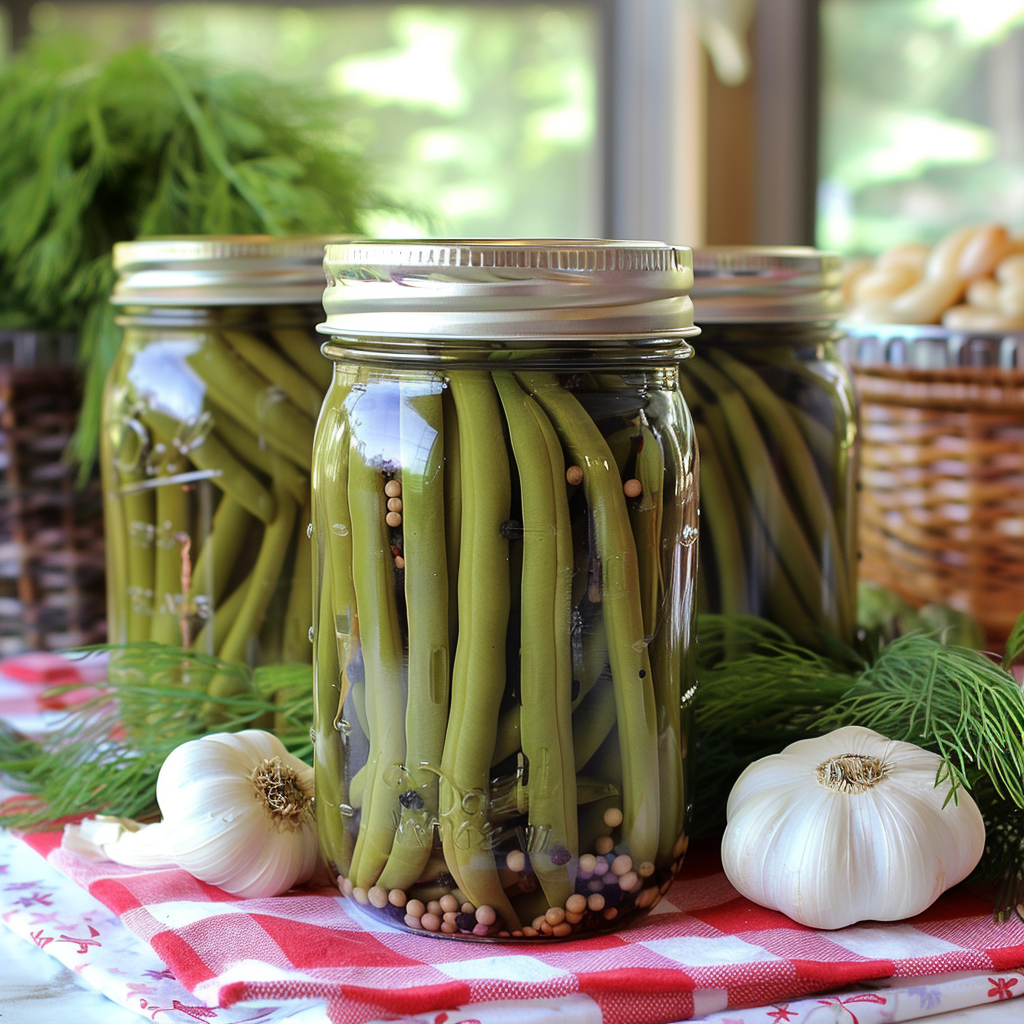How to Make Spicy Dilly Beans: A Family Tradition

Share
Dilly Beans: A Family Tradition Spiced to Perfection
In our family, it’s funny how certain recipes become the specialty of one member, and for us, dilly beans are my niece's domain. She’s the master when it comes to this tangy, crunchy delight, and let me tell you, the spicier, the better in her book. Every year, we gather at her house, arms full of fresh green beans and all the fixings, and we turn the kitchen into a bustling hub of activity. As we chop, measure, and prepare, the room fills with laughter and stories—mostly about how our mom used to orchestrate these canning days when we were kids. My niece keeps the tradition alive with her twist, adding just the right amount of red pepper flakes to give the beans that perfect kick. These spicy dilly beans have become a staple with certain family meals, a prized dish that everyone looks forward to. And, of course, they make fantastic Christmas gifts; after all, what could be better than a homemade jar of pickles crafted with love and care?
Did You Know?
Dilly beans are a traditional pickled green bean recipe that originated in the United States. They are particularly popular in the southern states and are known for their crisp texture and dill flavor. These pickles are a great way to preserve the bounty of summer green beans.
Yield: 6-7 pints
Ingredients:
- 2 pounds fresh green beans, trimmed to fit your jars
- 2 1/2 cups white vinegar (5% acidity)
- 2 1/2 cups water
- 1/4 cup pickling salt
- 6-7 cloves garlic, peeled
- 6-7 heads of fresh dill or 3-4 tablespoons dill seeds
- 1 tablespoon black peppercorns
- Optional: 1 teaspoon red pepper flakes for a spicy kick
Instructions:
Personal Tip: Sterilizing jars and lids is crucial for long-lasting, safe storage, ensuring the dilly beans stay crisp and delicious.
1. Prepare the Jars:
- Sterilize Jars: Wash jars, lids, and bands in hot, soapy water. Rinse well. Place jars in a large pot, cover with water, and boil for 10 minutes. Keep jars hot until ready to use.
Personal Tip: Trimming the beans to fit your jars makes packing them easier and helps keep them crisp.
2. Prepare the Brine:
- Boil Brine: In a large pot, combine vinegar, water, and pickling salt. Bring to a boil, stirring until the salt is dissolved.
Personal Tip: Adding red pepper flakes gives the beans a spicy kick that many in our family love.
3. Prepare the Beans:
- Trim Beans: Wash and trim the ends of the green beans so they fit into your jars.
Personal Tip: Packing the beans tightly ensures they stay upright and look beautiful in the jar.
4. Pack the Jars:
- Add Spices and Dill: To each hot jar, add 1 clove of garlic, 1 head of dill or 1/2 tablespoon dill seeds, 4-5 peppercorns, and red pepper flakes if using.
- Pack Beans: Pack the green beans tightly into the jars, standing them upright, leaving 1/2-inch headspace.
- Add Brine: Pour the hot brine over the beans, maintaining the 1/2-inch headspace. Remove air bubbles by running a non-metallic spatula around the inside of the jar.
Personal Tip: Properly removing air bubbles helps prevent spoilage and ensures a good seal.
5. Process the Jars:
- Wipe Rims and Apply Lids: Wipe jar rims with a clean, damp cloth. Apply lids and screw bands until fingertip tight.
- Boiling Water Bath: Place jars in a boiling water canner. Ensure they are covered by at least 1-2 inches of water. Process for 10 minutes (adjust time based on altitude).
- Cool Jars: Remove jars and place them on a towel to cool for 12-24 hours. Do not disturb while cooling.
- Check Seals: After cooling, check seals. Lids should not flex up and down when pressed. Store in a cool, dark place for up to a year.
Nutritional Information (Per Serving - 5 dilly beans):
Calories: 10, Protein: 1g, Carbohydrates: 2g, Fat: 0g, Sugars: 1g
Why Use Pickling Salt for All Pickle Recipes:
- Purity: Pickling salt is free from additives like iodine and anti-caking agents that can cause cloudiness or off-flavors in the brine.
- Dissolution: It dissolves easily and completely, ensuring even distribution and preventing residue buildup.
- Consistency: Ensures consistent flavor and preservation quality across all batches of pickles.
How This Applies to Different Pickling Recipes:
- Cucumber Pickles: Whether you’re making dill, bread and butter, or sweet pickles, pickling salt ensures a clear brine and consistent texture.
- Vegetable Pickles: For mixed vegetable pickles, using pickling salt helps maintain the bright colors and crunchiness of the vegetables.
- Fruit Pickles: In recipes like pickled peaches or watermelon rind pickles, pickling salt helps preserve the delicate flavors and clarity of the pickling liquid.
- Relishes and Chutneys: For relishes and chutneys, pickling salt ensures the final product remains visually appealing and free from unwanted additives.
Kitchen Tips, Great Ideas, How to Save Money:
- Choose Fresh Beans: Use fresh, firm green beans for the best results. Avoid beans that are overly mature or have blemishes.
- Sterilization is Key: Always sterilize jars and lids to prevent contamination and ensure a long shelf life.
- Trim to Fit: Trim beans to fit the height of your jars for a neat and tidy appearance.
- Proper Sealing: Ensure lids are fingertip tight, not over-tightened, to allow air to escape during processing.
- Headspace is Important: Leave the correct amount of headspace to allow for expansion during processing and to ensure a proper seal.
- Remove Air Bubbles: Removing air bubbles prevents trapped air, which can lead to spoilage. Use a non-metallic utensil to avoid damaging jars.
- Storage Conditions: Store dilly beans in a cool, dark place to maintain quality and prevent spoilage. Avoid storing near heat sources or in direct sunlight.
- Labeling Jars: Always label jars with the date and contents. This helps keep track of inventory and ensures you use older jars first.
- Reuse and Recycle: Save money by reusing jars from store-bought products. Just ensure they are properly sterilized before use.
- Adjust Spices: Customize the spice level to your liking. Add more garlic, dill, or pepper flakes to create a unique flavor profile.
Let's Learn About Green Beans
Green beans, also called string beans or snap beans, are a versatile vegetable found in many cuisines. They grow from the common bean plant (Phaseolus vulgaris) and are harvested while still tender.
How They’re Grown
Green beans thrive in warm climates and well-drained soil. They are planted after the last frost in spring and mature within 50-60 days. There are two main types: bush beans, which grow low and compact, and pole beans, which need support to grow vertically.
Harvesting
Beans are typically harvested by hand while the pods are young and tender. Overripe beans can become tough and fibrous. At this stage, the beans inside the pods aren’t fully developed, which is why they have that perfect crispness.
Fresh vs. Frozen
Fresh green beans are best when used shortly after picking, retaining their texture and flavor. Frozen beans are a great alternative, as they’re picked and frozen at peak freshness, preserving their nutrients.
What to Watch For
Choose vibrant green, firm beans with smooth pods. Avoid those with brown spots or large seeds. For fewer pesticides, consider organic or locally grown options.
Green beans are also a great source of vitamins A, C, and K, as well as fiber, making them a nutritious addition to any meal.


